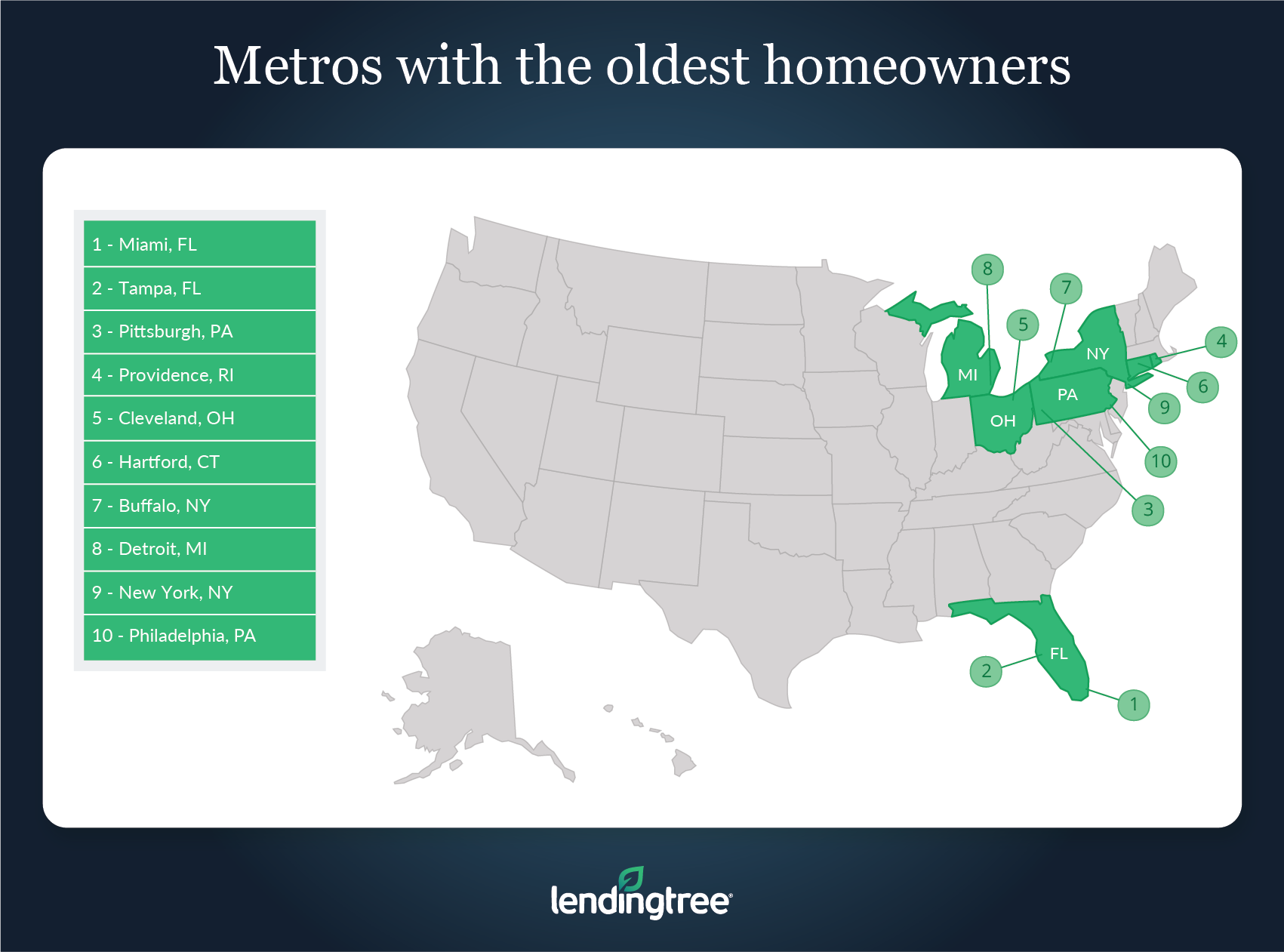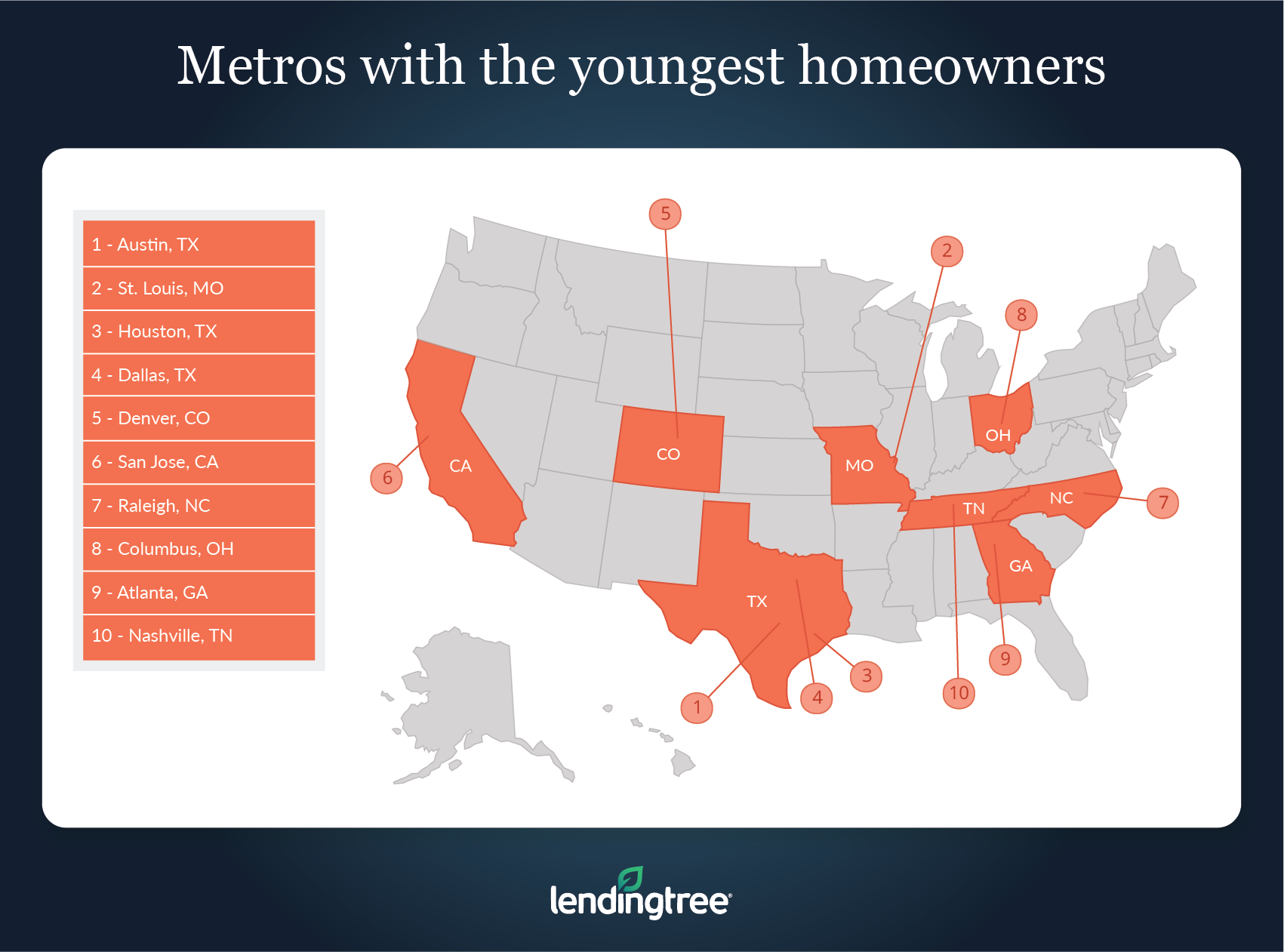Metros With the Oldest — and Youngest — Homeowners
It’s no surprise that homeowners of various ages gravitate toward different parts of the country. Florida is a well-known haven for retirees, while Salt Lake City and Minneapolis have emerged in recent years as popular spots for younger homebuyers. As a result, the average age of people living in given areas can be notably different.
Using the latest available U.S. Census Bureau data, LendingTree looked at the average ages of homeowners and renters across the nation’s 50 largest metropolitan areas.
LendingTree found that Miami and Tampa, Fla., were the metros where homeowners were the oldest, while renters were older in Pittsburgh and New York.
Key findings
- The average age of a homeowner across the nation’s 50 largest metros is between 51 and 52 years old. In only nine metros was the average homeowner age under 50.
- The two metros with the oldest homeowners — Miami and Tampa — are in Florida. Florida has historically been a popular destination for older homeowners for various reasons, including no income tax and a warm climate.
- Younger homeowners like Texas. The lowest average age for homeowners across the nation’s 50 largest metros is between 47 and 48 in Austin, Texas. While St. Louis has the second-youngest homeowners, it’s followed by two more Texas metros — Houston and Dallas.
- Renters are usually younger than homeowners and the overall population. Across the nation’s 50 largest metros, the average renter is almost 33 years old — nearly 19 years younger than the average homeowner and almost six years younger than the overall population.
- Renters on the East Coast are usually older. The average age of renters in Pittsburgh, New York and Providence, R.I. — the metros with the oldest renters — is about 36. The cost of renting in these areas is a little bit less expensive relative to the costs of owning a home in other parts of the country, which might incentivize some people to rent later in their lives.
Metros with the highest average homeowner age
No. 1: Miami
- Average homeowner age: 54.47
- Average renter age: 34.99
- Average age of general population: 40.97
- Median monthly housing costs (with a mortgage): $1,829
- Median monthly gross rent: $1,363
No. 2: Tampa, Fla.
- Average homeowner age: 54.19
- Average renter age: 34.08
- Average age of general population: 41.63
- Median monthly housing costs (with a mortgage): $1,458
- Median monthly gross rent: $1,115
No. 3: Pittsburgh
- Average homeowner age: 53.79
- Average renter age: 36.49
- Average age of general population: 42.10
- Median monthly housing costs (with a mortgage): $1,335
- Median monthly gross rent: $831

Metros with the lowest average homeowner age
No. 1: Austin, Texas
- Average homeowner age: 47.58
- Average renter age: 31.29
- Average age of general population: 35.99
- Median monthly housing costs (with a mortgage): $1,909
- Median monthly gross rent: $1,273
No. 2: St. Louis
- Average homeowner age:48.77
- Average renter age: 29.64
- Average age of general population: 34.45
- Median monthly housing costs (with a mortgage): $1,627
- Median monthly gross rent: $1,114
No. 3: Houston
- Average homeowner age: 49.00
- Average renter age: 30.11
- Average age of general population: 35.37
- Median monthly housing costs (with a mortgage): $1,738
- Median monthly gross rent: $1,101

Why do different areas attract people of various ages?
As people age, they tend to look for different things in housing. For example, a retiree who lives alone would probably look for a smaller home than a 33-year-old with a spouse and two kids.
Generally, older people tend to stick to the eastern U.S., where they often live in warm, retirement-friendly metros like Miami and Tampa, Fla. or in more expensive areas like Providence, R.I., or New York, where they’ve built enough wealth to comfortably afford to live. That being said, older homeowners are also common in less expensive and colder eastern U.S. metros like Pittsburgh.
On the flip side, younger people often gravitate toward less expensive areas like Texas. And when they do congregate in costly metros like San Jose, Calif. or Denver, they’re often doing so because they’re looking to start a career in an area with a robust job market.
3 tips for older homebuyers
Whether they’re thinking about downsizing for retirement or looking for a change of scenery, there are many reasons why older Americans purchase homes. With that in mind, here are a few tips for older homebuyers:
- Shop around for a mortgage before getting a loan. Because older Americans tend to have more wealth and higher credit scores, they can often qualify for better rates on their loans. However, that doesn’t mean that the first lender will give them their best rate. By shopping around for a mortgage, older buyers can increase their odds of being offered a lower rate and, in turn, lower their monthly mortgage payments.
- Look into different loan programs. While the traditional 30-year, fixed-rate mortgage can be an option for older buyers, many other loan programs may be even better. For example, those near retirement age may qualify for a retirement mortgage, which can help them get around income requirements that they’re likely to find with other loans.
- Don’t completely drain savings to buy a house. Because homes bought outright (without a loan) or with a large down payment tend to be less expensive in the long run, it may seem tempting to spend a lot of cash on a house. This is especially true for older homebuyers who have significant savings or who don’t want to deal with a loan as they age. However, even if they have the money to buy outright, they may still be better off getting a loan. After all, it’s important to have cash in reserves to cover unexpected expenses.
Methodology
LendingTree researchers analyzed data for the nation’s 50 largest metropolitan statistical areas to determine which metros were home to the oldest and youngest homeowners, as well as the oldest and youngest renters.
All the data comes from the U.S. Census Bureau’s 2019 American Community Survey one-year estimates — the latest available — as derived from the Integrated Public Use Microdata Series (IPUMS).
